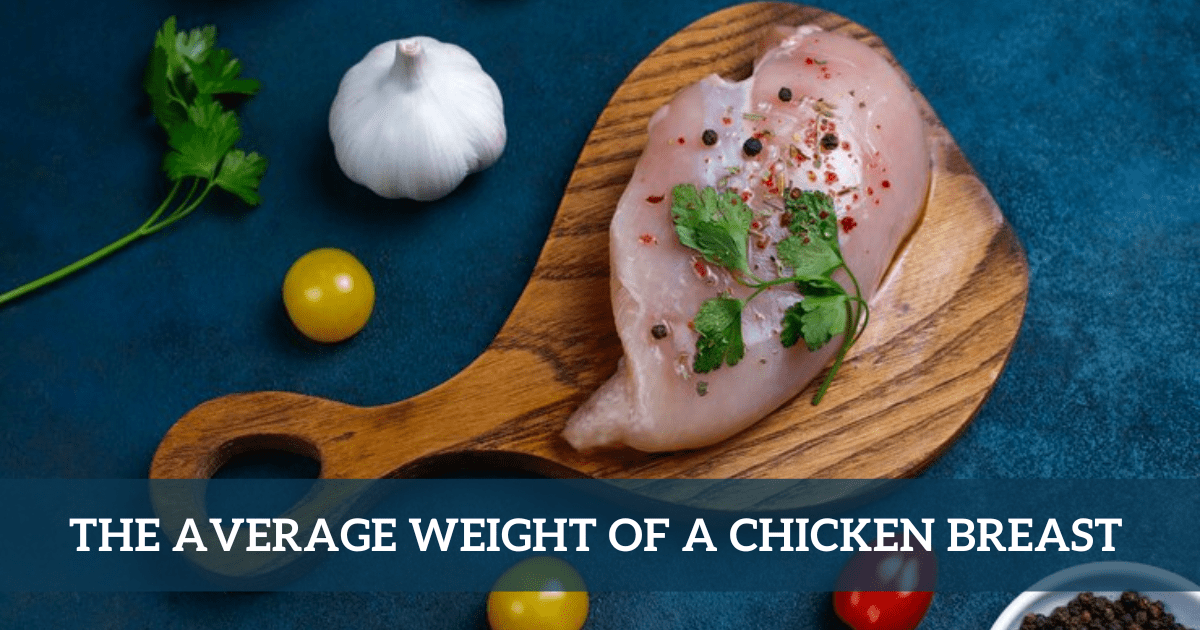The average weight of a chicken breast can vary depending on factors such as the breed of chicken, its age, and how it’s been raised. However, a typical chicken breast bought at a grocery store usually weighs around 6 to 8 ounces (170 to 227 grams) before cooking. Keep in mind that this is just an average, and individual chicken breasts may weigh more or less.
Introduction to Weight Average Chicken Breast
When it comes to poultry, chicken breast is a popular choice among health-conscious people and gourmet connoisseurs alike. Chicken breast is well-known for its lean protein content and adaptability in the kitchen, and it is used in a variety of recipes worldwide. However, among the different possibilities accessible, the concept of weight average chicken breast stands out as an important consideration for consumers looking for consistency in their culinary activities.
Weight average chicken breast is a standardized way to selecting and distributing chicken breasts based on their weight. Unlike traditional purchasing methods, where individual parts can vary greatly in size and weight, weight average chicken breast provides a more consistent and predictable product. This uniformity is crucial for both home cooks and commercial enterprises, as it ensures an even cooking experience and constant serving sizes.
Importance of Weight Average in Chicken Breasts
Weight average in chicken breasts is crucial for consistent cooking, portion control, and nutritional accuracy. It ensures even cooking, preventing overcooked portions and undercooked ones. Consistent weight allows for better portion control, especially in commercial kitchens. Consistency in weight leads to predictable cooking results, allowing cooks to adjust seasoning and flavors accordingly.
Weight average chicken breasts also provide accurate measurement of protein and calorie consumption, supporting health and wellness goals. They enhance presentation in culinary settings, showcasing attention to detail and quality. Consistency in quality enhances customer satisfaction, while standardized weights reduce labor costs and increase production efficiency. They also accommodate various cooking methods, ensuring optimal results and a superior dining experience.
Factors Affecting Weight Average
Several factors can alter the weight distribution of chicken breasts, affecting their consistency and homogeneity. Understanding these aspects is critical for manufacturers, suppliers, and consumers alike. Here are some important considerations:
Breed and Genetics:
- Breeds and genetics can affect chicken breast size and weight.
- Breeds selected for higher breast size may result in heavier chicken breasts.
Age of the Chicken:
- Age at processing time can affect breast size and weight.
- Consistency in processing age can aid in weight maintenance.
Feed and Nutrition:
- Chickens’ growth and development are influenced by diet and nutrition.
- A balanced diet high in protein and minerals can lead to larger and heavier chicken breasts.
Growth Hormones and Antibiotics:
- Use of growth hormones and antibiotics can affect chicken breast growth rate and size.
Processing Methods:
- Consistent processing processes are required for consistent weight.
Handling and Storage:
- Proper handling and storage standards during transit and distribution are crucial.
Grading and Sorting:
- Effective sorting techniques ensure uniform weight average.
Market Demand:
- Consumer tastes and market demand for specific chicken breast sizes can affect weight average.
By taking these aspects into account and executing corrective steps, producers and suppliers may maintain a consistent weight average for chicken breasts, ensuring consumer quality and satisfaction. Furthermore, understanding these characteristics enables consumers to make informed decisions when buying chicken products based on their preferences and dietary requirements.

How to Calculate Average Weight of Chicken Breasts
To calculate the weight average of chicken breasts, first determine the average weight of a sample set of chicken breasts. Here’s a step-by-step instruction for calculating the weight average:
- Choose a representative sample of chicken breasts from the wider population.
- Weigh each chicken breast using a precision-calibrated scale.
- Calculate the overall weight by adding the weights of all chicken breasts in the sample.
- Count the chicken breasts to determine the total number in the sample.
- Calculate the weight average by dividing the total weight of all chicken breasts by the sample size.
- Interpret the results to determine the weight average of one chicken breast in the sample set.
- Assess variability measures like standard deviation or range to understand the distribution of weights within the sample.
- Repeat the method regularly with new chicken breast samples for larger populations or continuous monitoring.
Following these methods will allow you to compute the weight average of chicken breasts, which will be useful for both producers and consumers in terms of the product’s normal size and weight. This information can be used to manage inventory, restrict portion sizes, and ensure quality.
Quality Indicators of Chicken Breast
Quality indicators for weight-average chicken breast are critical for ensuring that consumers obtain a product that fulfills their flavor, texture, and overall satisfaction. Here are some important quality factors to consider:
- Appearance: Weight-average chicken breasts should be uniform in size, shape, and color. Consistent appearance shows proper sorting and processing, resulting in a visually appealing product.
- Texture: High-quality, weight-average chicken breasts should be firm and durable. They should not feel too soft or mushy to the touch, as this could suggest a problem with freshness or incorrect storage.
- Moisture Content: Moisture content is a key quality factor for chicken breasts. While they should be wet and succulent, undue moisture loss can lead to dry and rough meat. Proper packaging and storage strategies aid in retaining optimal moisture levels.
- Flavor: Weight-average chicken breasts should have a mild, delicious flavor with no unpleasant aromas or tastes. Fresh chicken breasts should smell clean and poultry-like, indicating that they are fresh.
- Tenderness: Tender chicken breasts are ideal for culinary uses. Weight-average chicken breasts should have a sensitive bite without being too chewy or rough, indicating adequate processing and handling.
- Defect-devoid: High-quality, weight-average chicken breasts should be devoid of surface flaws such as bruising, discolouration, or blemishes. Any obvious flaws could suggest mismanagement or quality difficulties during processing.
- Safety: Safety is an important quality criteria for chicken breasts. Products must be free of hazardous diseases and pollutants to protect customer health and well-being. Adherence to strict food safety standards and regulations is critical for ensuring product quality and safety.
Producers, suppliers, and consumers can evaluate these quality indicators to determine the overall quality of weight average chicken breasts and ensure that they meet or exceed expectations in terms of flavor, texture, safety, and consistency.
Easy Ways To Measure A Chicken Breast
Chicken Breast Measuring Guide
- Use kitchen scale for precise measurements.
- Compare chicken breast to familiar objects and standard serving sizes.
- Use measuring cups for shredded or cubed chicken.
- Measure thickness with a ruler or thumb.
- Mark chicken breast before cooking for uniform cooking and portion sizes.
- Use pre-cut portions for consistent portion sizes.
- Choose method that works best for your needs and equipment availability.

Benefits of Opting for Weight Average Chicken Breast
Choosing weight average chicken breast has various advantages for both consumers and culinary specialists. Here are some of the main advantages:
- Maintains consistent portion sizes, aiding in meal planning and portion control.
- Promotes even cooking, reducing undercooked or overdone sections.
- Allows for precise cooking times, enhancing the dining experience.
- Enhances presentation, resulting in a visually appealing dish.
- Improves meal prep efficiency, saving time and effort in the kitchen.
- Enhances nutritional accuracy, allowing accurate calculation of protein, fat, and calorie content.
- Reduces food waste, ensuring only necessary preparation, saving money and reducing environmental impact.
In conclusion, choosing weight-average chicken breasts provides various advantages, including uniform portion sizes, even cooking, predictable cooking times, superior appearance, increased meal prep efficiency, nutritional accuracy, less food waste, and higher customer satisfaction. These benefits make weight-average chicken breasts a popular choice among discerning consumers and culinary professionals alike.
Nutritional Value of Chicken Breast
Weight average chicken breast has a plethora of nutritional benefits, making it a popular choice among health-conscious people. Here’s an overview of its nutritional value:
- High Protein: Provides essential protein for tissue building, muscle growth, and overall health.
- Low in Fat: Low in saturated fat, making it a heart-healthy protein choice.
- Low in Calories: Compared to higher-fat cuts of meat, it’s low in calories, making it suitable for calorie control and weight loss goals.
- Rich in Essential Nutrients: Provides vitamins B6 and B12, niacin, phosphorus, and selenium, crucial for metabolism, energy production, and immune function.
- Versatile: Can be prepared in various ways to suit different tastes and culinary preferences.
- Promotes Muscle Health: High protein content supports muscle health and development.
- Promotes Satiety: Protein-rich foods like chicken breast promote feelings of fullness and satiety, aiding in a balanced diet and weight management.
To summarize, weight-average chicken breast provides an excellent balance of protein, low fat, low calories, necessary nutrients, versatility, and satiety. By including it into your diet on a regular basis, you can get the nutritious benefits while also enjoying great and satisfying meals.
Are Chickens Bigger Now Than They Used To Be?
Yes, chickens raised for meat production are often larger than they were in the past. Over the years, selective breeding and advances in agricultural operations have resulted in the introduction of chicken breeds that are specifically designed for enhanced meat production. These modern breeds are genetically designed to develop faster and produce more meat than traditional or heritage breeds.
To address the expanding global demand for poultry meat, selective breeding efforts have concentrated on features like as quick growth, increased muscle mass, and higher feed conversion efficiency. As a result, modern chickens grown for meat, often known as broilers, achieve market weight at a younger age and have a bigger overall body size than chickens raised decades ago.
How Many Chicken Breasts Are There In A Pound?
The number of chicken breasts per pound varies according on the size and weight of each individual chicken breast. On average, a pound contains 2 to 3 boneless, skinless chicken breasts. This estimate assumes that the chicken breasts are medium-sized and weigh 6 to 8 ounces each. Keep in mind that actual numbers may vary depending on the breed of chicken, processing processes, and personal choice for portion sizes.
Tips for Selecting the Best Chicken Breast
Choosing the best weight average chicken breast requires taking into account a number of aspects to ensure you receive a high-quality product. Here are some pointers to help you select the best weight average chicken breast:
- Check for Freshness: Look for firm, pinkish breasts, avoiding sticky, discolored, or strong odors.
- Inspect Packaging: Check for tears, leaks, or damage in pre-packaged chicken breasts. Ensure proper sealing and protection.
- Seek Uniformity: Choose packages with consistent size and thickness for weight-average chicken breasts.
- Check the Sell-By Date: Verify the chicken breasts’ freshness by checking the expiration date on the packaging.
- Choose Organic or Free-Range Options: Choose chicken breasts of superior quality, raised without antibiotics or hormones, and with better flavor and texture.
- Inspect for Excess Liquid: Select packages with minimal purging to ensure freshness.
- Ask Questions: Ask about the chicken’s origin, raised methods, and other facts for informed selection.
- Consider Cooking Needs: Choose uniform thickness for even cooking, larger, meatier for shredded or cubed chicken.
By following these guidelines, you can choose the optimum weight average chicken breasts for your culinary demands, resulting in a delicious and gratifying meal every time.

Read More: Purple Fizzy Juice Recipe For Weight Loss
Conclusion
Weight-average chicken breasts provide a handy and nutritious protein source in regular serving sizes. Understanding how to choose, prepare, and consume them can improve your culinary experience while also benefiting your health and well-being.
Frequently Asked Questions
What is an average weight for a chicken breast?
A weight average chicken breast is a method for determining the average weight of chicken breasts in a pack. It’s equivalent to summing up all the weights and then dividing by the number of chicken breasts.
Why is weight average significant while purchasing chicken breasts?
Weight average tells you what to expect in terms of size and weight from the chicken breasts you’re purchasing. It can help you plan your meals more effectively and ensure that you get the proper amount of chicken for your recipes.
How do I determine the weight average of chicken breasts?
To find the weight average of chicken breasts, add the weight of all the chicken breasts in a pack and divide by the number of chicken breasts. For example, if you have four chicken breasts weighing 8 ounces, 7 ounces, 9 ounces, and 8.5 ounces, put them together (8 + 7 + 9 + 8.5 = 32.5) and divide by four (because there are four chicken breasts), you will get an average weight of 8.125 ounces.
Does the average weight impact cooking time?
Yes, the weight distribution of chicken breasts can influence cooking time. Larger chicken breasts may take longer to cook than smaller breasts. When following, it is necessary to pay attention to the average weight.
How can I verify that the weight average is consistent while purchasing chicken breasts?
When purchasing chicken breasts, seek for packs labeled with similar sizes or weights to maintain consistent weight averages. Purchasing from trustworthy suppliers or butchers can also assist ensure that you are receiving chicken breasts of consistent weight. If you’re buying individual chicken breasts, weigh them to ensure they’re near in weight.









Leave a Reply